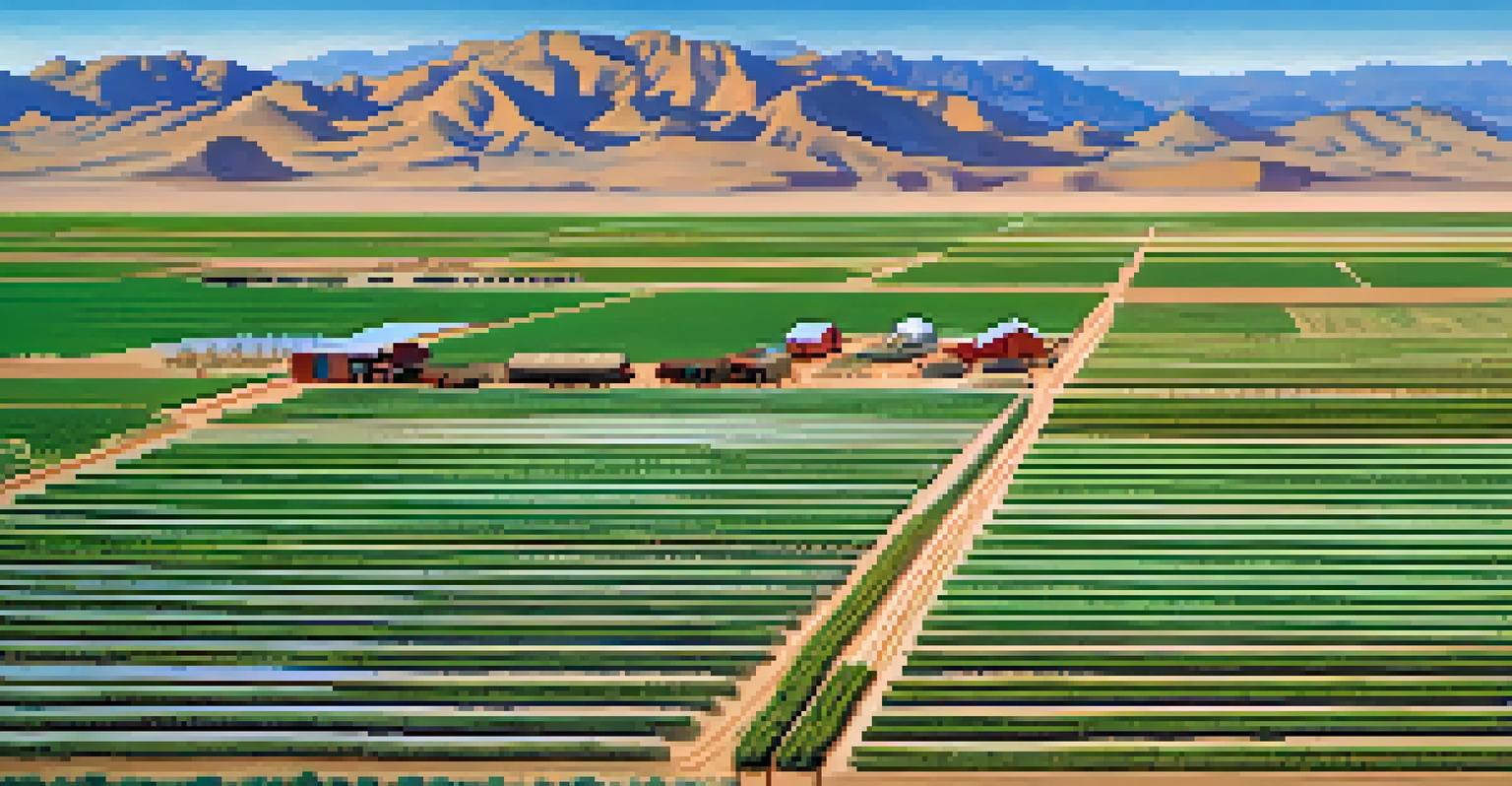Human Impact on Nevada's Desert Climate and Natural Resources

Understanding Nevada's Unique Desert Environment
Nevada is home to a remarkable desert ecosystem characterized by its arid climate, unique flora, and fauna. The Mojave and Great Basin deserts dominate much of the landscape, each offering a distinct array of species adapted to survive in harsh conditions. Understanding this environment is crucial as it sets the stage for how human actions can disrupt these delicate ecosystems.
We won't have a society if we destroy the environment.
The desert's climate features extreme temperatures, with scorching summers and chilly winters, making water a precious resource. Plants like the Joshua tree and various cacti have adapted to conserve moisture, while animals have developed behaviors to cope with the heat. This intricate balance is easily disturbed by external factors, highlighting the need for sustainable practices.
As we explore the human impact on this beautiful yet fragile environment, it’s important to recognize that our actions can have long-lasting consequences. From urban development to tourism, every decision influences the natural world around us, making it essential to tread carefully in this unique desert landscape.
Urbanization and Its Effects on Desert Ecosystems
Urbanization in Nevada, particularly in areas like Las Vegas, has led to significant changes in the desert landscape. As cities expand, natural habitats are often replaced with buildings, roads, and infrastructure, disrupting local ecosystems. This transformation can lead to the loss of biodiversity, as native species struggle to adapt to rapidly changing environments.

Moreover, urban areas consume vast amounts of water, which is a critical resource in the desert. The demand for water often exceeds the natural supply, leading to over-extraction from rivers and aquifers. This not only affects the availability of water for local wildlife but also alters the hydrology of the region, further stressing the ecosystem.
Urbanization Strains Desert Ecosystems
The rapid expansion of urban areas in Nevada disrupts local habitats and threatens biodiversity.
The rise of urban heat islands, where city temperatures soar higher than surrounding areas, also contributes to climate change effects. This phenomenon can exacerbate drought conditions and impact the delicate balance of desert life. As we continue to build and expand, it’s crucial to consider sustainable urban planning that minimizes harm to our precious desert ecosystems.
Agricultural Practices and Water Resource Management
Agriculture plays a vital role in Nevada's economy, but it also significantly impacts the desert environment. Traditional farming methods often require large amounts of water, which is a scarce resource in such arid regions. This demand can lead to the depletion of essential water sources, making it harder for both humans and wildlife to thrive.
The Earth does not belong to us: we belong to the Earth.
Additionally, the use of pesticides and fertilizers can pollute local water supplies and harm desert wildlife. These chemicals can runoff into nearby streams and rivers, impacting the delicate ecosystems that depend on clean water. As a result, agricultural practices need to evolve towards more sustainable methods that protect both crops and the environment.
Innovative approaches, such as drip irrigation and crop rotation, can help mitigate some of these negative impacts. By adopting water-efficient techniques, farmers can reduce their environmental footprint while ensuring food security. It's a delicate balance, but with careful management, agriculture can coexist with Nevada's unique desert climate.
Tourism and Its Impact on Natural Resources
Tourism is a double-edged sword for Nevada's deserts; it brings economic benefits but also poses significant challenges. Popular destinations like Red Rock Canyon and the Valley of Fire attract millions of visitors each year, which can lead to environmental degradation. Increased foot traffic can damage native plants and disrupt wildlife habitats, threatening the very landscapes that draw tourists in.
Moreover, the infrastructure required to support tourism—hotels, restaurants, and roads—often encroaches on natural areas, leading to habitat fragmentation. This can result in isolated populations of wildlife, making it difficult for species to thrive. Additionally, litter and pollution from visitors can further harm these pristine environments.
Sustainable Practices in Agriculture
Adopting water-efficient farming methods can help mitigate the environmental impact of agriculture in arid regions.
However, responsible tourism practices can help mitigate these impacts. Educating visitors about the importance of conservation and promoting sustainable activities can foster a deeper appreciation for Nevada's deserts while protecting them. By prioritizing eco-friendly tourism, we can enjoy the beauty of the desert without compromising its future.
Climate Change: A Growing Threat to Desert Ecosystems
Climate change is an overarching challenge that affects desert climates globally, and Nevada is no exception. Rising temperatures and altered precipitation patterns can exacerbate the already harsh conditions of the desert, putting immense pressure on local ecosystems. This can lead to increased droughts, which threaten both wildlife and human livelihoods.
Additionally, climate change can shift plant and animal distributions, forcing species to adapt or migrate to survive. As habitats change, the delicate balance of these ecosystems can be disrupted, leading to a decline in biodiversity. For instance, native species may struggle to compete with invasive species that thrive in warmer conditions.
Addressing climate change requires collective action, from individual lifestyle changes to large-scale policy initiatives. By reducing greenhouse gas emissions and promoting renewable energy sources, we can help mitigate some of the adverse effects of climate change. Protecting Nevada's desert ecosystems is not just about preserving nature; it's about ensuring a sustainable future for all.
Conservation Efforts: Protecting Nevada's Natural Heritage
In response to the growing threats to Nevada's desert ecosystems, various conservation efforts have been put in place. Organizations and government agencies work together to protect endangered species and restore damaged habitats. These initiatives often include habitat restoration projects, wildlife corridors, and educational outreach programs aimed at raising awareness about the importance of conservation.
Community involvement is also essential for successful conservation efforts. Local residents can play a vital role by participating in volunteer programs, advocating for sustainable practices, and supporting policies that prioritize environmental protection. Engaging the community helps create a sense of stewardship for the desert, ensuring that its natural resources are preserved for future generations.
Education Fosters Environmental Stewardship
Increasing awareness and hands-on learning about conservation can inspire communities to protect Nevada's unique desert ecosystems.
Additionally, partnerships between private enterprises and conservation groups can lead to innovative solutions for sustainable land use. By combining resources and expertise, these collaborations can help balance human needs with ecological preservation. Together, we can protect Nevada's unique desert heritage for years to come.
The Role of Education in Promoting Sustainable Practices
Education is a powerful tool in fostering a culture of sustainability, especially in regions like Nevada. By increasing awareness of the challenges facing the desert environment, we can inspire individuals and communities to take action. Schools, community organizations, and public outreach programs play a crucial role in teaching about the importance of conservation and responsible resource management.
Hands-on learning experiences, such as field trips to natural reserves or workshops on sustainable practices, can engage people of all ages. These activities not only educate but also create a personal connection to the desert, encouraging participants to become advocates for its protection. When people understand the impact of their choices, they are more likely to adopt sustainable habits.

Furthermore, integrating sustainability into local policies and curricula can create long-term changes within the community. By prioritizing environmental education, we can empower future generations to make informed decisions that benefit both people and nature. Together, we can cultivate a culture of respect and care for Nevada's desert ecosystems.